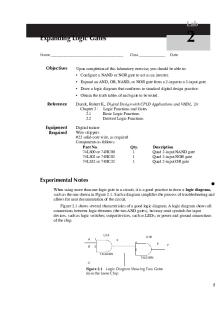Chapter 11 - dont remember prof PDF

| Title | Chapter 11 - dont remember prof |
|---|---|
| Course | Introduction To Chemistry |
| Institution | Southern Illinois University Edwardsville |
| Pages | 1 |
| File Size | 54.6 KB |
| File Type | |
| Total Downloads | 59 |
| Total Views | 140 |
Summary
dont remember prof...
Description
Chapter 11 Gases
Kinetic Molecular Theory o Gases are the least dense phase of matter o Consist of free gaseous atoms/molecules in constant random motion, colliding with other molecules and their container Gas Behavior o Expand to fill container o Compressible o Pressure is the result of gas molecules colliding with their container o Earth’s atmosphere exerts pressure at its surface due to its mass o This pressure is assigned a value of 1 atmosphere (atm) at sea level o Common units of pressure 1 atm = 14.7 lb/in2(psi) = 101,325 Pa =101.325 kPa Perfect vacuum is 0 atm Pressure of outer space is 10-13 torr Atmospheric Pressure o Supports the column to a height of 760 mmHg o Units of pressure 1 atm = 760 mm Hg 1 atm = 29.92 in Hg 1 atm = 760 torr 1 atm = 14.7 psi Kinetic Molecular Theory o Four key description of an ideal gas Collection of particles in constant motion No attractions or repulsions between molecules; collisions are inelastic Space between molecules are much, much larger than molecules themselves Average kinetic energy (KE = ½ mv2) proportional to temperature; increasing velocity of molecules increases temperature o This theory is sufficient for describing gas behavior in many cases o It is not appropriate in all circumstances. When would it fall? If the gas molecules become too close together (high pressure) If the assumption that there are no forces between gas molecules is incorrect (as it is in some cases) o Gases are compressible because of the large average distance (empty space) between molecules o Random motion will cause a gas introduced to a container to fill it o Gases less dense than solids and liquids because of the space between molecules o If 12 oz of water is boiled, the steam would fill 595 L (158 gal). Most of this is empty space...
Similar Free PDFs

Chapter 11 - dont remember prof
- 1 Pages

Lab 21 - I DONT REMEMBER
- 4 Pages

Lab 13 - I DONT REMEMBER
- 10 Pages

Lab 24 - I DONT REMEMBER
- 8 Pages

Lab 17 - I DONT REMEMBER
- 8 Pages

Lab 01 - I DONT REMEMBER
- 4 Pages

Lab 12 - I DONT REMEMBER
- 16 Pages

Assignment 7 - i dont remember
- 2 Pages

Lab 33 - I DONT REMEMBER
- 6 Pages

Lab 02 - I DONT REMEMBER
- 6 Pages

Tema 11 Prof. Sánchez Arjona.
- 4 Pages

Remember Miranda
- 36 Pages

Ch-11 - Chapter 11
- 11 Pages

Drugs to remember copy
- 16 Pages
Popular Institutions
- Tinajero National High School - Annex
- Politeknik Caltex Riau
- Yokohama City University
- SGT University
- University of Al-Qadisiyah
- Divine Word College of Vigan
- Techniek College Rotterdam
- Universidade de Santiago
- Universiti Teknologi MARA Cawangan Johor Kampus Pasir Gudang
- Poltekkes Kemenkes Yogyakarta
- Baguio City National High School
- Colegio san marcos
- preparatoria uno
- Centro de Bachillerato Tecnológico Industrial y de Servicios No. 107
- Dalian Maritime University
- Quang Trung Secondary School
- Colegio Tecnológico en Informática
- Corporación Regional de Educación Superior
- Grupo CEDVA
- Dar Al Uloom University
- Centro de Estudios Preuniversitarios de la Universidad Nacional de Ingeniería
- 上智大学
- Aakash International School, Nuna Majara
- San Felipe Neri Catholic School
- Kang Chiao International School - New Taipei City
- Misamis Occidental National High School
- Institución Educativa Escuela Normal Juan Ladrilleros
- Kolehiyo ng Pantukan
- Batanes State College
- Instituto Continental
- Sekolah Menengah Kejuruan Kesehatan Kaltara (Tarakan)
- Colegio de La Inmaculada Concepcion - Cebu

